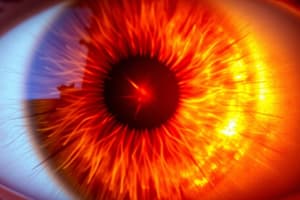Podcast
Questions and Answers
What is the primary reason for increased intraocular pressure (IOP) in glaucoma?
What is the primary reason for increased intraocular pressure (IOP) in glaucoma?
- Improper eye alignment
- Increased secretion of aqueous humor (correct)
- Decreased drainage of aqueous humor (correct)
- Decreased vision in low light conditions
Which type of glaucoma is characterized by a gradual increase in intraocular pressure due to blockages?
Which type of glaucoma is characterized by a gradual increase in intraocular pressure due to blockages?
- Primary angle-closure glaucoma
- Congenital glaucoma
- Primary open-angle glaucoma (correct)
- Secondary glaucoma
What is the expected reference range for intraocular pressure (IOP) in mm/Hg?
What is the expected reference range for intraocular pressure (IOP) in mm/Hg?
- 15 to 25
- 10 to 20 (correct)
- 5 to 15
- 20 to 30
Primary angle-closure glaucoma is defined by which characteristic event?
Primary angle-closure glaucoma is defined by which characteristic event?
Which condition is NOT a common cause of secondary glaucoma?
Which condition is NOT a common cause of secondary glaucoma?
What symptom is commonly associated with primary open-angle glaucoma?
What symptom is commonly associated with primary open-angle glaucoma?
Which of the following is a characteristic of primary angle-closure glaucoma?
Which of the following is a characteristic of primary angle-closure glaucoma?
What condition is typically associated with experiencing colored halos around lights?
What condition is typically associated with experiencing colored halos around lights?
Which symptom differentiates primary angle-closure glaucoma from primary open-angle glaucoma?
Which symptom differentiates primary angle-closure glaucoma from primary open-angle glaucoma?
What is most likely to increase during an episode of primary angle-closure glaucoma?
What is most likely to increase during an episode of primary angle-closure glaucoma?
What should be monitored to assess the progression of glaucoma in a patient?
What should be monitored to assess the progression of glaucoma in a patient?
What is the primary method of treatment for glaucoma?
What is the primary method of treatment for glaucoma?
Which technique should be employed after instilling eye drops to ensure their effectiveness?
Which technique should be employed after instilling eye drops to ensure their effectiveness?
Which of the following is NOT a recommended practice for administering prescribed eye medication?
Which of the following is NOT a recommended practice for administering prescribed eye medication?
What symptom should be assessed in patients with angle-closure glaucoma?
What symptom should be assessed in patients with angle-closure glaucoma?
Flashcards
Glaucoma
Glaucoma
Damage to the optic nerve due to increased pressure inside the eye.
Intraocular Pressure (IOP)
Intraocular Pressure (IOP)
Pressure inside the eye.
Primary Open-Angle Glaucoma (POAG)
Primary Open-Angle Glaucoma (POAG)
A common type of glaucoma where fluid drains slowly from the eye, causing gradual increase in pressure.
Primary Angle-Closure Glaucoma
Primary Angle-Closure Glaucoma
Signup and view all the flashcards
Normal IOP range
Normal IOP range
Signup and view all the flashcards
What is the usual IOP range in open-angle glaucoma?
What is the usual IOP range in open-angle glaucoma?
Signup and view all the flashcards
What are some symptoms of primary open-angle glaucoma?
What are some symptoms of primary open-angle glaucoma?
Signup and view all the flashcards
What is a hallmark of primary angle-closure glaucoma?
What is a hallmark of primary angle-closure glaucoma?
Signup and view all the flashcards
What are some symptoms of primary angle-closure glaucoma?
What are some symptoms of primary angle-closure glaucoma?
Signup and view all the flashcards
What is the difference between open-angle and angle-closure glaucoma?
What is the difference between open-angle and angle-closure glaucoma?
Signup and view all the flashcards
Tonometry
Tonometry
Signup and view all the flashcards
Angle-Closure Glaucoma
Angle-Closure Glaucoma
Signup and view all the flashcards
Punctal Occlusion
Punctal Occlusion
Signup and view all the flashcards
Glaucoma Medication
Glaucoma Medication
Signup and view all the flashcards
Study Notes
Glaucoma Overview
- Glaucoma is a disorder affecting the optic nerve.
- Increased intraocular pressure (IOP) damages the optic nerve, leading to vision loss.
- Normal IOP ranges from 10 to 20 mm/Hg.
Primary Glaucoma Types
- Primary Open-Angle Glaucoma (POAG):
- Most common type.
- Aqueous humor outflow is reduced due to blockages in the eye's drainage system (Canal of Schlemm and trabecular meshwork).
- IOP increases gradually.
- Primary Angle-Closure Glaucoma:
- IOP rises rapidly.
- The angle between the iris and sclera closes abruptly.
- Onset is sudden and urgent treatment is required.
Secondary Glaucoma
- Secondary glaucoma results from various factors, including:
- Trauma
- Eye surgery
- Eye tumors
- Uveitis
- Iritis
- Neovascular disorders
- Degenerative diseases
- Central retinal vein occlusion.
Glaucoma Importance
- Glaucoma is a leading cause of blindness.
- Early diagnosis and treatment are crucial to prevent vision loss.
Studying That Suits You
Use AI to generate personalized quizzes and flashcards to suit your learning preferences.




